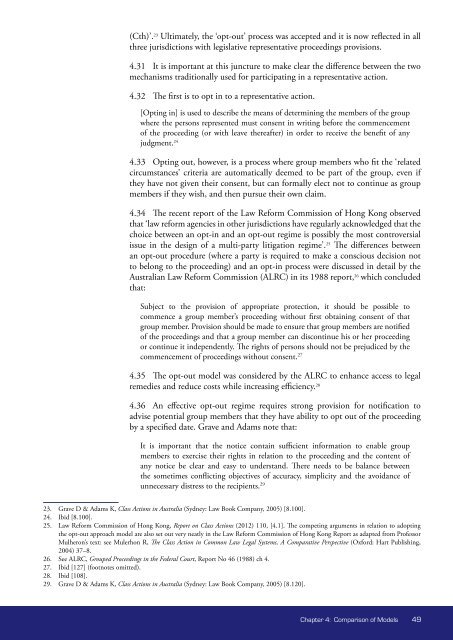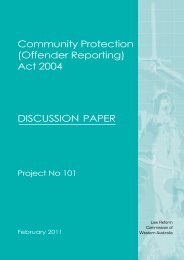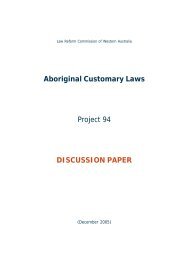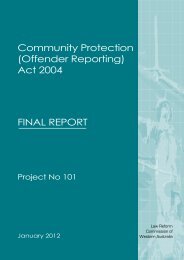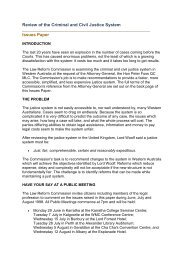Discussion Paper - Law Reform Commission of Western Australia
Discussion Paper - Law Reform Commission of Western Australia
Discussion Paper - Law Reform Commission of Western Australia
You also want an ePaper? Increase the reach of your titles
YUMPU automatically turns print PDFs into web optimized ePapers that Google loves.
(Cth)’. 23 Ultimately, the ‘opt-out’ process was accepted and it is now reflected in all<br />
three jurisdictions with legislative representative proceedings provisions.<br />
4.31 It is important at this juncture to make clear the difference between the two<br />
mechanisms traditionally used for participating in a representative action.<br />
4.32<br />
The first is to opt in to a representative action.<br />
[Opting in] is used to describe the means <strong>of</strong> determining the members <strong>of</strong> the group<br />
where the persons represented must consent in writing before the commencement<br />
<strong>of</strong> the proceeding (or with leave thereafter) in order to receive the benefit <strong>of</strong> any<br />
judgment. 24<br />
4.33 Opting out, however, is a process where group members who fit the ‘related<br />
circumstances’ criteria are automatically deemed to be part <strong>of</strong> the group, even if<br />
they have not given their consent, but can formally elect not to continue as group<br />
members if they wish, and then pursue their own claim.<br />
4.34 The recent report <strong>of</strong> the <strong>Law</strong> <strong>Reform</strong> <strong>Commission</strong> <strong>of</strong> Hong Kong observed<br />
that ‘law reform agencies in other jurisdictions have regularly acknowledged that the<br />
choice between an opt-in and an opt-out regime is possibly the most controversial<br />
issue in the design <strong>of</strong> a multi-party litigation regime’. 25 The differences between<br />
an opt-out procedure (where a party is required to make a conscious decision not<br />
to belong to the proceeding) and an opt-in process were discussed in detail by the<br />
<strong>Australia</strong>n <strong>Law</strong> <strong>Reform</strong> <strong>Commission</strong> (ALRC) in its 1988 report, 26 which concluded<br />
that:<br />
Subject to the provision <strong>of</strong> appropriate protection, it should be possible to<br />
commence a group member’s proceeding without first obtaining consent <strong>of</strong> that<br />
group member. Provision should be made to ensure that group members are notified<br />
<strong>of</strong> the proceedings and that a group member can discontinue his or her proceeding<br />
or continue it independently. The rights <strong>of</strong> persons should not be prejudiced by the<br />
commencement <strong>of</strong> proceedings without consent. 27<br />
4.35 The opt-out model was considered by the ALRC to enhance access to legal<br />
remedies and reduce costs while increasing efficiency. 28<br />
4.36 An effective opt-out regime requires strong provision for notification to<br />
advise potential group members that they have ability to opt out <strong>of</strong> the proceeding<br />
by a specified date. Grave and Adams note that:<br />
It is important that the notice contain sufficient information to enable group<br />
members to exercise their rights in relation to the proceeding and the content <strong>of</strong><br />
any notice be clear and easy to understand. There needs to be balance between<br />
the sometimes conflicting objectives <strong>of</strong> accuracy, simplicity and the avoidance <strong>of</strong><br />
unnecessary distress to the recipients. 29<br />
23. Grave D & Adams K, Class Actions in <strong>Australia</strong> (Sydney: <strong>Law</strong> Book Company, 2005) [8.100].<br />
24. Ibid [8.100].<br />
25. <strong>Law</strong> <strong>Reform</strong> <strong>Commission</strong> <strong>of</strong> Hong Kong, Report on Class Actions (2012) 110, [4.1]. The competing arguments in relation to adopting<br />
the opt-out approach model are also set out very neatly in the <strong>Law</strong> <strong>Reform</strong> <strong>Commission</strong> <strong>of</strong> Hong Kong Report as adapted from Pr<strong>of</strong>essor<br />
Mulheron’s text: see Mulerhon R, The Class Action in Common <strong>Law</strong> Legal Systems, A Comparative Perspective (Oxford: Hart Publishing,<br />
2004) 37–8.<br />
26. See ALRC, Grouped Proceedings in the Federal Court, Report No 46 (1988) ch 4.<br />
27. Ibid [127] (footnotes omitted).<br />
28. Ibid [108].<br />
29. Grave D & Adams K, Class Actions in <strong>Australia</strong> (Sydney: <strong>Law</strong> Book Company, 2005) [8.120].<br />
Chapter 4: Comparison <strong>of</strong> Models 49


